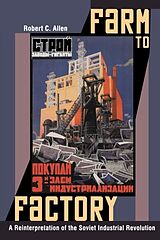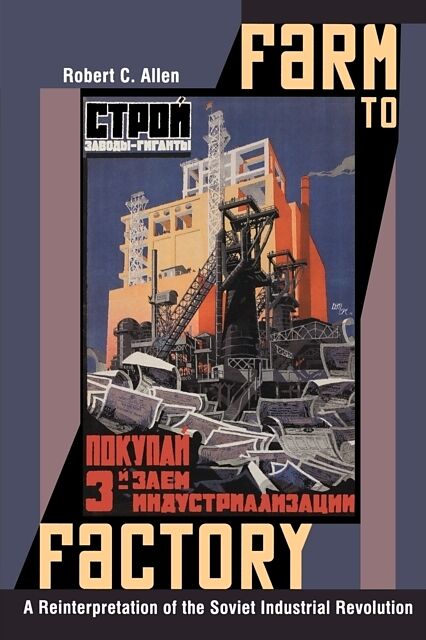Farm to Factory
Einband:
Kartonierter Einband
EAN:
9780691144313
Untertitel:
A Reinterpretation of the Soviet Industrial Revolution
Genre:
Allgemeines & Lexika
Autor:
Robert C. Allen
Herausgeber:
Princeton University Press
Anzahl Seiten:
322
Erscheinungsdatum:
26.07.2009
ISBN:
0691144311
Zusatztext "Robert Allen considers . . . contentions about the costs and achievements of industrialization and the collectivization of agriculture in the USSR." ---Paul Josephson, Technology and Culture Informationen zum Autor Robert C. Allen Klappentext To say that history's greatest economic experiment--Soviet communism--was also its greatest economic failure is to say what many consider obvious. Here, in a startling reinterpretation, Robert Allen argues that the USSR was one of the most successful developing economies of the twentieth century. He reaches this provocative conclusion by recalculating national consumption and using economic, demographic, and computer simulation models to address the "what if" questions central to Soviet history. Moreover, by comparing Soviet performance not only with advanced but with less developed countries, he provides a meaningful context for its evaluation.Although the Russian economy began to develop in the late nineteenth century based on wheat exports, modern economic growth proved elusive. But growth was rapid from 1928 to the 1970s--due to successful Five Year Plans. Notwithstanding the horrors of Stalinism, the building of heavy industry accelerated growth during the 1930s and raised living standards, especially for the many peasants who moved to cities. A sudden drop in fertility due to the education of women and their employment outside the home also facilitated growth.While highlighting the previously underemphasized achievements of Soviet planning, Farm to Factory also shows, through methodical analysis set in fluid prose, that Stalin's worst excesses--such as the bloody collectivization of agriculture--did little to spur growth. Economic development stagnated after 1970, as vital resources were diverted to the military and as a Soviet leadership lacking in original thought pursued wasteful investments. Zusammenfassung To say that history's greatest economic experiment--Soviet communism--was also its greatest economic failure is to say what many consider obvious. Here, in a startling reinterpretation, Robert Allen argues that the USSR was one of the most successful developing economies of the twentieth century. He reaches this provocative conclusion by recalculating national consumption and using economic, demographic, and computer simulation models to address the "what if" questions central to Soviet history. Moreover, by comparing Soviet performance not only with advanced but with less developed countries, he provides a meaningful context for its evaluation. Although the Russian economy began to develop in the late nineteenth century based on wheat exports, modern economic growth proved elusive. But growth was rapid from 1928 to the 1970s--due to successful Five Year Plans. Notwithstanding the horrors of Stalinism, the building of heavy industry accelerated growth during the 1930s and raised living standards, especially for the many peasants who moved to cities. A sudden drop in fertility due to the education of women and their employment outside the home also facilitated growth. While highlighting the previously underemphasized achievements of Soviet planning, Farm to Factory also shows, through methodical analysis set in fluid prose, that Stalin's worst excesses--such as the bloody collectivization of agriculture--did little to spur growth. Economic development stagnated after 1970, as vital resources were diverted to the military and as a Soviet leadership lacking in original thought pursued wasteful investments. Inhaltsverzeichnis List of Figures ix List of Tables xi Acknowledgments xiii Chapter One Soviet Development in World-Historical Perspective 1 Part One The Economy before Stalin 19 Chapter Two Economic Growth before 1917 21 Chapter Three The Development Problem in the 1920s 47 Chapter Four NEP Agriculture and Economic Development 65 Part Two Stalin's Indu...
Autorentext
Robert C. Allen
Klappentext
To say that history's greatest economic experiment--Soviet communism--was also its greatest economic failure is to say what many consider obvious. Here, in a startling reinterpretation, Robert Allen argues that the USSR was one of the most successful developing economies of the twentieth century. He reaches this provocative conclusion by recalculating national consumption and using economic, demographic, and computer simulation models to address the "what if" questions central to Soviet history. Moreover, by comparing Soviet performance not only with advanced but with less developed countries, he provides a meaningful context for its evaluation. Although the Russian economy began to develop in the late nineteenth century based on wheat exports, modern economic growth proved elusive. But growth was rapid from 1928 to the 1970s--due to successful Five Year Plans. Notwithstanding the horrors of Stalinism, the building of heavy industry accelerated growth during the 1930s and raised living standards, especially for the many peasants who moved to cities. A sudden drop in fertility due to the education of women and their employment outside the home also facilitated growth. While highlighting the previously underemphasized achievements of Soviet planning, Farm to Factory also shows, through methodical analysis set in fluid prose, that Stalin's worst excesses--such as the bloody collectivization of agriculture--did little to spur growth. Economic development stagnated after 1970, as vital resources were diverted to the military and as a Soviet leadership lacking in original thought pursued wasteful investments.
Inhalt
List of Figures ix List of Tables xi Acknowledgments xiii Chapter One Soviet Development in World-Historical Perspective 1 Part One The Economy before Stalin 19 Chapter Two Economic Growth before 1917 21 Chapter Three The Development Problem in the 1920s 47 Chapter Four NEP Agriculture and Economic Development 65 Part Two Stalin's Industrial Revolution 89 Chapter Five Planning, Collectivization, and Rapid Growth 91 Chapter Six The Population History of the USSR 111 Chapter Seven The Standard of Living 132 Chapter Eight The Causes of Rapid Industrialization 153 Chapter Nine Preobrazhensky in Action 172 Part Three After Stalin 187 Chapter Ten The Soviet Climacteric 189 Appendix A Soviet National Income 212 Appendix B The Simulation Model of the Soviet Economy 223 Appendix C Data Sources 238 Appendix D The Demographic Databases and Simulation Model Used in Chapter 6 249 Notes 253 Bibliography 271 Index 295

Leider konnten wir für diesen Artikel keine Preise ermitteln ...
billigbuch.ch sucht jetzt für Sie die besten Angebote ...
Die aktuellen Verkaufspreise von 5 Onlineshops werden in Realtime abgefragt.
Sie können das gewünschte Produkt anschliessend direkt beim Anbieter Ihrer Wahl bestellen.
Loading...
Die aktuellen Verkaufspreise von 5 Onlineshops werden in Realtime abgefragt.
Sie können das gewünschte Produkt anschliessend direkt beim Anbieter Ihrer Wahl bestellen.
| # | Onlineshop | Preis CHF | Versand CHF | Total CHF | ||
|---|---|---|---|---|---|---|
| 1 | Seller | 0.00 | 0.00 | 0.00 |
